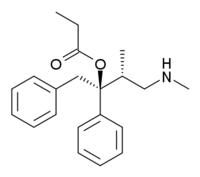Norpropoxyphene
 | |
| Names | |
|---|---|
| IUPAC name
[(2R,3R)-3-methyl-4-(methylamino)-1,2-di(phenyl)butan-2-yl] propanoate | |
| Identifiers | |
| 3376-94-1 | |
| 3D model (Jmol) | Interactive image |
| ChemSpider | 2341605 |
| PubChem | 3084563 |
| UNII | C812VVS96K |
| |
| |
| Properties | |
| C21H27NO2 | |
| Molar mass | 325.445 |
| Except where otherwise noted, data are given for materials in their standard state (at 25 °C [77 °F], 100 kPa). | |
| | |
| Infobox references | |
Norpropoxyphene is a major metabolite of the opioid analgesic drug dextropropoxyphene,[1] and is responsible for many of the side effects associated with use of this drug, especially the unusual toxicity seen during dextropropoxyphene overdose.[2][3][4] It has weaker analgesic effects than dextropropoxyphene itself, but is a relatively potent pro-convulsant and blocker of sodium and potassium channels,[5] particularly in heart tissue,[6][7] which produces prolonged intracardiac conduction time and can lead to heart failure following even relatively minor overdoses.[8][9][10][11] The toxicity of this metabolite makes dextropropoxyphene up to 10 times more likely to cause death following overdose compared to other similar mild opioid analgesics,[12] and has led to dextropropoxyphene being withdrawn from the market in some countries.[13]
Because norpropoxyphene has a long half-life in the body of up to 36 hours (compared to around 6–12 hours for dextropropoxyphene), it can accumulate in tissues during chronic use of dextropropoxyphene-containing medications, especially in people whose excretion of drugs is slower than normal such as young children, the elderly, and individuals with reduced kidney or liver function, and so side effects including serious adverse events are more common in these groups and use of dextropropoxyphene should be avoided where possible.[14][15][16]
References
- ↑ Somogyi AA, Menelaou A, Fullston SV. CYP3A4 mediates dextropropoxyphene N-demethylation to nordextropropoxyphene: human in vitro and in vivo studies and lack of CYP2D6 involvement. Xenobiotica. 2004 Oct;34(10):875-87. doi:10.1080/00498250400008371 PMID 15764408
- ↑ Gustafson A, Gustafsson B. Acute poisoning with dextropropoxyphene. Clinical symptoms and plasma concentrations. Acta Medica Scandinavica. 1976;200(4):241-8. PMID 983792
- ↑ McBay AJ. Propoxyphene and norpropoxyphene concentrations in blood and tissues in cases of fatal overdose. Clinical Chemistry. 1976 Aug;22(8):1319-21. PMID 949842
- ↑ Nickander RC, Emmerson JL, Hynes MD, Steinberg MI, Sullivan HR. Pharmacologic and toxic effects in animals of dextropropoxyphene and its major metabolite norpropoxyphene: a review. Human Toxicology. 1984 Aug;3 Suppl:13S-36S. PMID 6090306
- ↑ Nickander R, Smits SE, Steinberg MI. Propoxyphene and norpropoxyphene: pharmacologic and toxic effects in animals. Journal of Pharmacology and Experimental Therapeutics. 1977 Jan;200(1):245-53. PMID 13200
- ↑ Lund-Jacobsen H. Cardio-respiratory toxicity of propoxyphene and norpropoxyphene in conscious rabbits. Acta Pharmacologica et Toxicologica (Copenhagen). 1978 Mar;42(3):171-8. PMID 580345
- ↑ Ulens C, Daenens P, Tytgat J. Norpropoxyphene-induced cardiotoxicity is associated with changes in ion-selectivity and gating of HERG currents. Cardiovascular Research. 1999 Dec;44(3):568-78. PMID 10690289
- ↑ Young RJ. Dextropropoxyphene overdosage. Pharmacological considerations and clinical management. Drugs. 1983 Jul;26(1):70-9. PMID 6349964
- ↑ Lawson AA, Northridge DB. Dextropropoxyphene overdose. Epidemiology, clinical presentation and management. Medical Toxicology and Adverse Drug Experience. 1987 Nov-Dec;2(6):430-44. PMID 3323775
- ↑ Afshari R, Maxwell S, Dawson A, Bateman DN. ECG abnormalities in co-proxamol (paracetamol/dextropropoxyphene) poisoning. Clinical Toxicology (Philadelphia). 2005;43(4):255-9. PMID 16035201
- ↑ Simkin S, Hawton K, Sutton L, Gunnell D, Bennewith O, Kapur N. Co-proxamol and suicide: preventing the continuing toll of overdose deaths. QJM. 2005 Mar;98(3):159-70. PMID 15728397
- ↑ Afshari R, Good AM, Maxwell SR, Bateman DN. Co-proxamol overdose is associated with a 10-fold excess mortality compared with other paracetamol combination analgesics. British Journal of Clinical Pharmacology. 2005 Oct;60(4):444-7. PMID 16187978
- ↑ Sandilands EA, Bateman DN. Co-proxamol withdrawal has reduced suicide from drugs in Scotland. British Journal of Clinical Pharmacology. 2008 Aug;66(2):290-3. PMID 18489609
- ↑ Gibson TP, Giacomini KM, Briggs WA, Whitman W, Levy G. Propoxyphene and norpropoxyphene plasma concentrations in the anephric patient. Clinical Pharmacology and Therapeutics. 1980 May;27(5):665-70. PMID 7371364
- ↑ Inturrisi CE, Colburn WA, Verebey K, Dayton HE, Woody GE, O'Brien CP. Propoxyphene and norpropoxyphene kinetics after single and repeated doses of propoxyphene. Clinical Pharmacology and Therapeutics. 1982 Feb;31(2):157-67. PMID 7056023
- ↑ Flanagan RJ, Johnston A, White AS, Crome P. Pharmacokinetics of dextropropoxyphene and nordextropropoxyphene in young and elderly volunteers after single and multiple dextropropoxyphene dosage. British Journal of Clinical Pharmacology. 1989 Oct;28(4):463-9. PMID 2590604